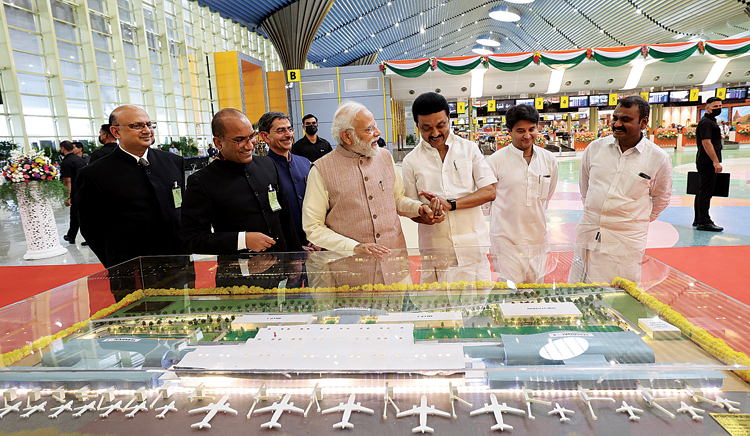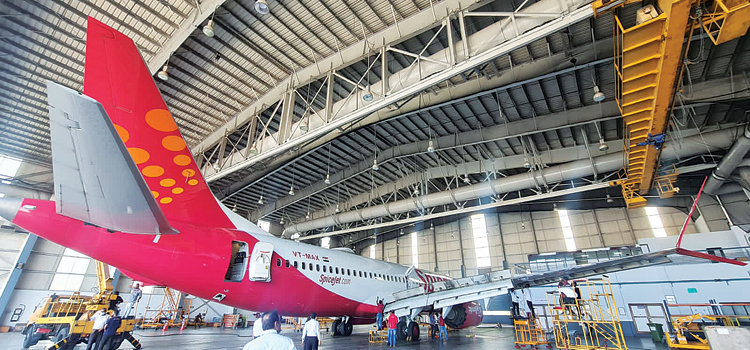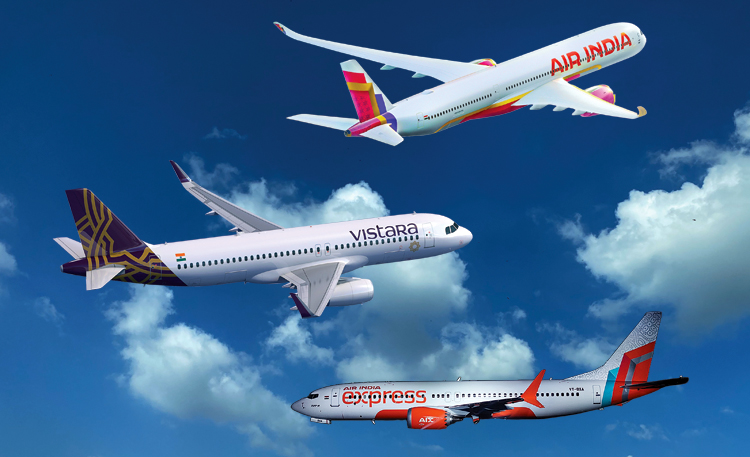INDIAN ARMED FORCES CHIEFS ON
OUR RELENTLESS AND FOCUSED PUBLISHING EFFORTS

SP Guide Publications puts forth a well compiled articulation of issues, pursuits and accomplishments of the Indian Army, over the years

I am confident that SP Guide Publications would continue to inform, inspire and influence.

My compliments to SP Guide Publications for informative and credible reportage on contemporary aerospace issues over the past six decades.
India’s Aviation Resurgence
The saga of Aviation in India is truly unfolding as the sector recovers from the challenges of the pandemic and takes flight towards prosperity by the end of this decade

India’s civil aviation sector stands as a cornerstone of the nation’s rapid economic growth, experiencing robust recovery and unprecedented expansion after the challenges posed by the COVID-19 pandemic. This projected momentum is intrinsically tied to the industry’s anticipated growth from $10.89 billion in 2023 to $12.55 billion by 2028, reflecting a Compound Annual Growth Rate (CAGR) of 2.87 per cent over the forecast period.
The Boeing Commercial Market Outlook 2023 further solidifies India’s aviation ascendancy, earmarking 90 per cent of the projected 2,700 new airplanes for South Asia in the next two decades for India. Forecasts from Boeing align with the aspirations for India’s commercial aviation market to ascend into the top three globally by 2041, trailing only China and the United States. The optimism is also substantiated by the India Brand Equity Foundation (IBEF), which points to a fully recovered air traffic movement of 327.28 million in FY23, an impressive surge from 188.89 million in FY22. Projections by the International Air Transport Association (IATA) posit India to secure the third spot in the world’s air passenger market by 2030.
FACTORS FACILITATING INDIA’S AVIATION GROWTH
The industry’s resilience is evident in the rebound of domestic passenger air traffic, surpassing pre-pandemic levels and showcasing the pent-up demand for travel. The convergence of government and private sector investments in infrastructure development becomes pivotal in sustaining this growth, propelled by rising household incomes, the emergence of low-cost carriers, increased Foreign Direct Investment (FDI), and an expanding GDP. The burgeoning middle class, characterised by increasing disposable incomes, propels the demand for air travel both domestically and internationally. This surge benefits aircraft manufacturers, Maintenance, Repair, and Overhaul (MRO) providers, and related service industries. Furthermore, the burgeoning e-commerce sector fuels the demand for narrow-body conversions, while the expansion of India’s electronics manufacturing industry, especially in higher-value segments, amplifies cargo demand. The Government’s regional connectivity schemes significantly broaden air travel access, making it more inclusive.

India, recognised as a global manufacturing hub, emerges as a prime market for aircraft manufacturers, with airlines placing substantial orders to meet the surging demand for air travel. This enthusiastic response from the aviation industry aligns with India’s soon-to-be largest population status, positioning it as an underserved yet burgeoning market. Aviation advisory and research firm CAPA India’s recent report anticipates resilient air traffic, reaching 155 million passengers in the fiscal year 2023-24. Despite unexpected challenges such as the grounding of Go First and the lingering impacts of supply chain disruptions, the report underscores the industry’s robustness. As the aviation sector steers through dynamic shifts and challenges, India emerges as a beacon of growth, beckoning stakeholders to navigate this burgeoning landscape with strategic foresight and resilience.
India’s airline system, anchored by industry leaders like IndiGo and the Air India group, has achieved stability, and a duopoly of the two is expected to drive the Indian aviation market
Domestic Air Traffic Anticipates a Surge: India’s domestic air traffic is poised for a robust 15 per cent increase, reflecting the industry’s resilience despite ongoing challenges. Concurrently, the international air traffic aligns with CAPA’s projections, aiming for approximately 70 million passengers by year-end. Despite hurdles faced by the aviation sector, overall profitability is anticipated to converge with CAPA’s initial estimate, indicating a projected $1.648 billion loss.
Profitability Dynamics: Full-service carriers are envisaged to contribute significantly to this loss, with estimates ranging from $1.4-1.5 billion, while low-cost carriers are positioned to incur losses within the $200-300 million range.
IndiGo’s Record Profit: A notable revision in the outlook for low-cost carriers’ losses is attributed to IndiGo’s exceptional profitability in the first quarter. IndiGo is on track to achieve a record profit of $500 million, demonstrating resilience even amid operational challenges stemming from Pratt & Whitney engine issues in FY2024. IndiGo also placed the largest-ever single order with Airbus, ordering 500 A320 family aircraft, with deliveries from 2030 to 2035.
Air India Group’s Expansion Endeavors: The Air India Group is making substantial strides in expansion, with plans to augment its fleet by over 60 aircraft by the fiscal year-end. This strategic growth encompasses Air India, Air India Express, and Vistara, collectively propelling the total fleet size toward the 300 aircraft mark. Air India also secured the largest aircraft contract, signing for up to 290 Boeing and 250 Airbus planes, including 10 777Xs, 20 787s, and additional options.
Ticket Prices and Fleet Grounding: A gradual normalisation of domestic and international ticket prices from post-pandemic highs has arrived, despite ongoing challenges related to the aircraft shortage. Over 150 aircraft belonging to Indian airlines are currently grounded, a number expected to potentially rise to 200 by March 2024, as highlighted by consultancy CAPA India in its mid-year outlook. The grounding situation, including the impact of Go First’s bankruptcy and supply chain disruptions, underscores the industry’s remarkable adaptability.

Stable Airline System and Competitive Dynamics: Amid these challenges, India’s airline system, anchored by industry leaders like IndiGo and the Air India group, has achieved stability, and a duopoly of the two is expected to drive the Indian aviation market. This stability is also set to catalyse heightened competitive dynamics between these two major airline groups, ushering in a new era in the Indian aviation market from 2024, according to insights from CAPA India. Additionally, the anticipated growth of Akasa Air and the potential revival of SpiceJet are poised to further contribute to the evolving competitive landscape in the domestic market.
CHALLENGES IN INDIA’S AVIATION GROWTH
In the promising landscape of India’s civil aviation sector, challenges arise amid rapid growth, demanding a strategic approach to navigate a complex array of obstacles.
Operational Constraints and Mitigation Strategies: Despite these ambitious growth plans, there are severe operational constraints faced by India’s carriers. Out of a projected 789 aircraft, only 588 are expected to be operational by yearend. Airlines like IndiGo and SpiceJet are addressing these capacity shortfalls by inducting aircraft on wet lease arrangements, with projections indicating up to 30 wet-leased aircraft operating in India by March 2024. SpiceJet is facing serious financial woes, despite which it was bidding for the grounded Go First (founded as GoAir).
Aviation Fuel Taxation Conundrum: A multifaceted challenge confronts India’s domestic airline industry in the form of high taxes on Aviation Turbine Fuel (ATF). ATF, constituting a substantial portion of airline operating costs—sometimes soaring to 40-45 per cent—poses a stark contrast to global counterparts where fuel costs range between 20-30 per cent. These elevated taxes strain financial viability, potentially curtailing margins, prompting route exits, and instigating fare hikes, thereby impeding sectoral growth. A potential remedy could involve bringing ATF under the GST regime at an optimised rate. In the short term, reductions in excise duty and Value-Added Tax (VAT) on ATF by central and state governments could provide immediate relief to airlines.
The Boeing Commercial Market Outlook 2023 further solidifies India’s aviation ascendancy, earmarking 90 per cent of the projected 2,700 new airplanes for South Asia in the next two decades for India
Financing, Infrastructure & Policies: As India prepares for an influx of over 2,700 new airplanes, the imperative for robust infrastructure and policies to sustain growth becomes evident. With lessors playing an increasingly pivotal role in India’s aviation landscape, the establishment of resilient financing mechanisms is crucial. One of the main infrastructure challenges faced by the aviation industry in India is the need for adequate airport facilities. Another challenge is the need for more runway capacity. As the number of flights and passengers continues to grow, there is a need for more runways to accommodate the increased traffic. Key challenges in this regulatory framework include the need for greater clarity and consistency in policies, a slow pace of regulatory reform, and a requirement for enhanced transparency and accountability in the regulatory process. A more streamlined, clearer, and efficient regulatory framework is necessary for the industry’s growth and development.

Bolstering MRO Capabilities: Amid India’s burgeoning aviation fleet, the necessity for robust MRO capabilities becomes paramount. Ensuring aircraft safety and reliability demands substantial investments in MRO infrastructure and expertise, fostering not only safety but also job creation and technological advancement in the aviation sector. Currently, MRO is decentralised, with critical segments contractually governed by Original Equipment Manufacturers (OEMs). While India handles line and hangar maintenance (constituting less than 20 per cent of total MRO expenditure), over 80 per cent is outsourced abroad, primarily for component and engine maintenance. The challenge lies predominantly in component and engine MRO, where significant spending occurs. Efforts to fortify India’s MRO capabilities, especially in components and engines, are imperative to support the burgeoning aviation sector, generate employment, and enhance technological prowess.
CAPA India is foreseeing a notable 15 per cent surge in air traffic for 2023-2024, translating to an estimated 155 million passengers
According to the Ministry of Civil Aviation (MoCA), 2023 has been an eventful year for them given the following achievements:
- 60 New RCS (Regional Connectivity Scheme) routes commenced in 2023; 154 New RCS Routes awarded under UDAN (Ude Desh ka Aam Nagrik); 12 new RCS routes commenced in North East
- More than 91 lakh passengers availed of the facility of Digi Yatra, and over 35 lakh users downloaded the app
- 3 more Greenfield airports operationalised
- 456 more posts of Air Traffic Controllers Created
- 34 Directorate General of Civil Aviation (DGCA)-approved Flying Training Organisations (FTOs) operating at 55 bases till November 2023
- DGCA issued an all-time high, of 1,562 Commercial Pilot Licenses
- About nine thousand remote pilot certificates were issued through the Digital Sky Platform
- India’s domestic air passenger traffic touched record high
- The Government of India has so far accorded ‘in-principle’ approval for setting up 21 Greenfield Airports across the country. Out of these, 12 Greenfield airports have been operationalised, three in 2023.
- Presently, 66 airports across the country are running with 100 per cent Green Energy.
- The country was facing an acute shortage of Air Traffic Control Officers (ATCOs). The Ministry, with the concurrence of DPE, approved the creation of 456 more posts of ATCOs in April 2023.
- DGCA has processed 23,908 flight crew licensing issues and renewal applications to date through the single window digital platform of eGCA during 2023.
- On November 19, 2023, airlines in India flew 4,56,910 domestic passengers. This was the highest single-day air traffic since the pandemic hit, marking a remarkable 7.4 per cent surge above pre-COVID averages-a clear sign of recovery and resilience in the skies.
- MoU between DGCA and the European Union Aviation Safety Agency (EASA) was signed in Brussels for technical cooperation in Unmanned Aircraft Systems and Innovative Air Mobility.
- In FY 2022-23, around 29.43 crores were disbursed under the PLI Scheme for Drones. The Drone (Amendment) Rules, 2023 now allow alternative proofs of identity for issuing Remote Pilot Certificates. There are 76 DGCA-approved Remote Pilot Training Organisations, and 8,680 RPCs have been issued till December 18, 2023, via the Digital Sky Platform.
- As per the National Civil Aviation Policy, 2016, Open Sky Arrangement allows unlimited flights over and above the existing bilateral rights directly to/from six Indian Metro Airports (Delhi, Mumbai, Kolkata, Chennai, Hyderabad and Bengaluru). In 2022, India entered into open sky arrangements with Maldives and Canada, and with New Zealand in 2023. As of October 2023, India has open sky arrangements with 24 countries.
- 137 Aviation Assets including 18 aircraft, 63 aircraft engines, and 56 ground support equipment have been leased by aircraft leasing entities registered from GIFT IFSC as of October 31, 2023.
- To promote ‘Ease of Doing Business’ and enhance aviation safety, the Aircraft (First Amendment) Rules, 2023 were officially notified on October 10, 2023. Among the changes, the validity of licenses for Airline Transport Pilot License (ATPL) and Commercial Pilot License (CPL) holders has been extended from five to ten years. Various amendments have been introduced to facilitate ease of doing business.
With optimism throughout the year, despite some turbulences, the Indian aviation industry is almost set for a smooth flight in 2024 and accelerate its journey toward becoming one of the largest aviation markets.





